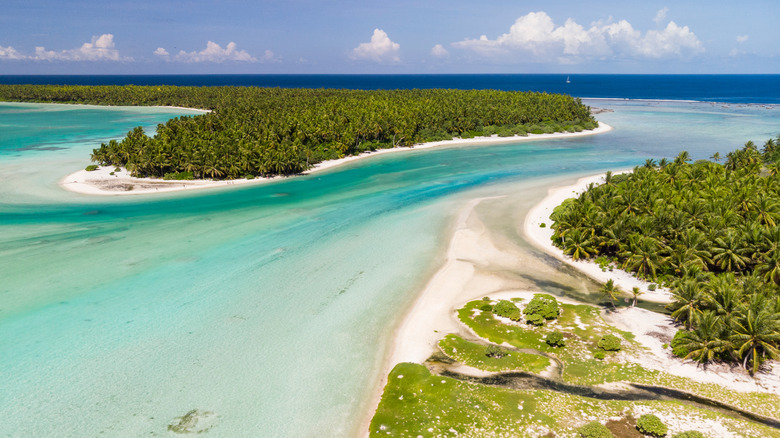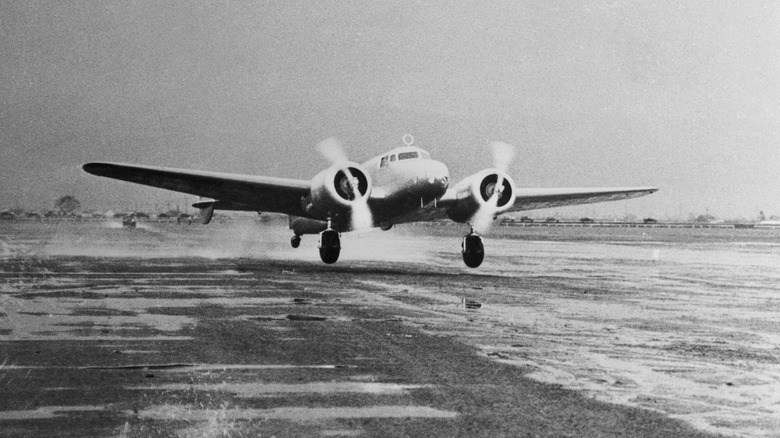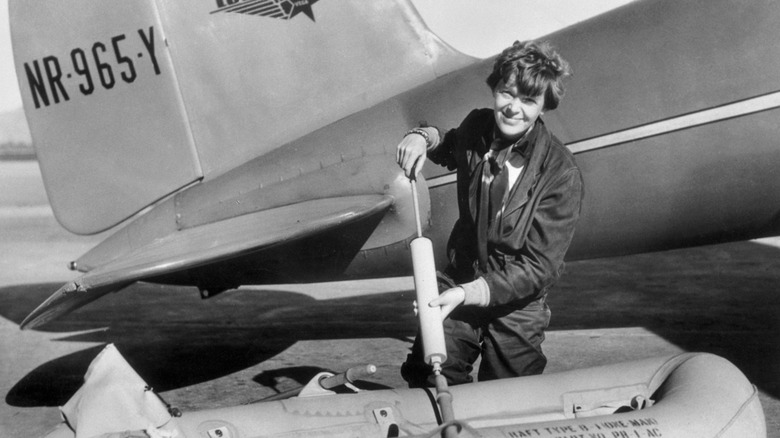Why Aerial Footage From 1938 Might Be Final Clue In Solving The Amelia Earhart Plane Mystery
On July 2, 1937, the famed aviator Amelia Earhart and her navigator Fred Noonan took off in a twin-engine Lockheed 10-E Electra from Lae, New Guinea, headed for Howland Island, 2,600 miles east across the Pacific Ocean where they planned to refuel. Earhart and Noonan had already traveled 22,000 miles on a quest to fly around the world. They had only two more stops to go after Howland Island — Honolulu, Hawaii, and Oakland, California — and just 7,000 miles. The Electra never made it to Howland Island, and a subsequent 16-day search by the U.S. Navy and Coast Guard failed to find Earhart, Noonan, or the plane.
Earhart's disappearance remains the biggest mystery in aviation history. But recently uncovered photographs from 1938, a year after her mysterious vanishing, have strengthened investigators' beliefs that the wreckage of Earhart's Electra is located in a lagoon on Nikumaroro Island, about 350 miles from Howland Island. The photos, backed by more recent satellite and drone footage, appear to show a metallic-looking object near the island, which has been dubbed the Taraia Object after the part of the island where it's located. A joint investigation involving 15 researchers from Purdue University in West Lafayette, Indiana, and the non-profit educational organization Archeological Legacy Institute (ALI) plan to visit the remote island in the South Pacific that could contain the dark secret of Earhart's fate in 2026 to determine if the Taraia Object is indeed Earhart's long-lost plane.
Was Amelia Earhart marooned?
This isn't the first time Nikumaroro Island (formerly Gardner Island) has been considered a possible location where Amelia Earhart's life ended. Since 1989, investigators from the International Group for Historic Aircraft Recovery (TIGHAR), have been looking into the possibility and have visited the island multiple times. The hypothesis is that Earhart and Fred Noonan landed on the island and continued to use the plane's radio to send out distress calls until the tide rose high enough to sweep the plane into the water.
The U.S. Navy did come close to Nikumaroro and sent planes over the island that was filled with dense jungle, but at a fairly high altitude. They didn't find the Electra. However, they did see what looked like "signs of recent habitation" on the island, according to the official report (via the U.S. Naval Institute). The planes flew over several times with no response from the ground and continued on, believing no one was there. There was additional evidence besides the 1938 aerial photos taken by the New Zealand military that Earhart and Noonan may have ended up on the island. Colonists who moved there in the late 1930s reported finding plane wreckage, human bones, and a woman's shoe, among other artifacts. Additionally, later researchers turned up various materials consistent with what would have been found on the Electra. The latest evidence seems to support the hypothesis.
What the photos purport to show
Michael Ashmore, an Amelia Earhart researcher, first discovered the Taraia Object in 2020 on satellite imagery. Since then, investigators have found more images of the anomaly, including the 1938 photographs taken by a survey team from New Zealand. They were there scouting the island as a site for a coconut plantation and village. Based on these images and later satellite and drone footage, investigators have surmised that the Taraia Object is the tail, fuselage, and a piece of the starboard wing of Earhart's Lockheed Electra.
Still, this isn't the first time someone has claimed they've found Earhart's plane. In January 2024, explorer Tony Romeo alleged he'd found the remains of the aircraft 16,000 feet down on the floor of the Pacific Ocean, about 100 miles from Howland Island. A further investigation determined it was a rock formation. Time will tell if the photos from Nikumaroro turn out to be the actual wreckage or something else completely. The search team is set to visit the island sometime in 2026.
A new search set for 2026
The 15-member team from Purdue University and the ALI was originally set to go to Nikumaroro Island in November 2025 on its three-week expedition. But the trip has been delayed amid continued negotiations to get proper permits from the government of the Republic of Kiribati, the country in Micronesia that owns the island. Additionally, the winter months are the cyclone season in that part of the Pacific, requiring them to wait. The island, which has been uninhabited since 1963 when the colonists abandoned it amid a drought, is not easy to get to. The team will have to take a ship from the Marshall Islands and endure a six-day journey across the open ocean to Nikumaroro.
Once there, they plan on doing remote sensing, photography, sonar, and magnetometry, before dredging the sediment believed to be covering the Taraia Object so they can finally identify it. The evidence already collected, including the recently uncovered photos from 1938, are tantalizing enough for the researchers to make the tough journey to the island and for many people to hope that the 88-year-old mystery of what happened to the famed aviator is finally at its end.



